

THE CINEMATOGRAPHY AND ARTISTRY OF 'THE TERMINATOR'
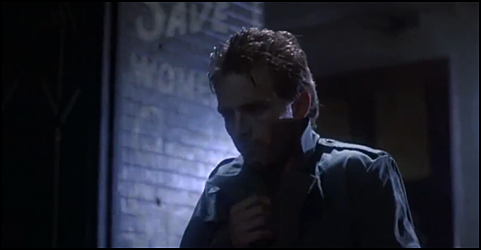
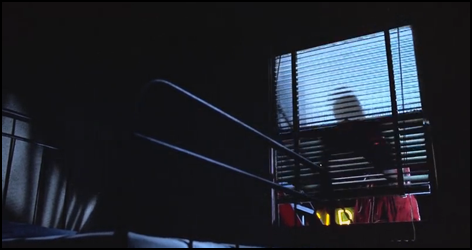
Director James Cameron states that his film influences (on the cinematography) are the German Impressionists of the Thirties, and Film Noir of the Forties. "That was exactly how I saw it when I first read the script", says Adam Greenberg. "I was aiming for a cold look, lots of dark shadows, strong back light, a very strong, hard, contrasty look" (American Cinematographer 1985)
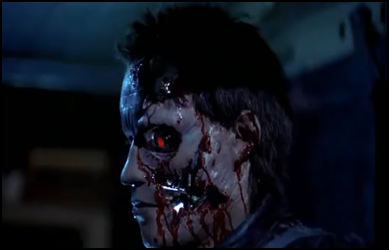
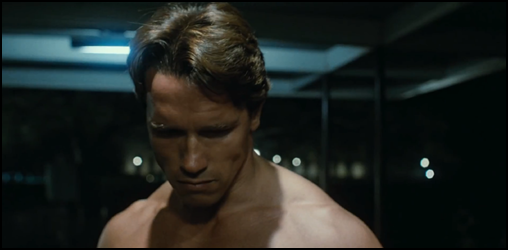 Photographed
by Adam Greenberg, ASC and directed by James Cameron, “The Terminator” is a film
that employs a bare minimum of exposition and lets the visual storytelling do
the heavy lifting in orienting the audience to where the movie is going. It’s a
masterpiece of plant and payoff, in terms of both story points and visual
design. From the first shot and moving forward, the images are constantly
referencing each other by contrast and affinity, making us understand a great
deal without literal exposition. The photography in the opening scenes of “The
Terminator” is especially effective: the images immediately establish the theme
of the film as well as several key character and story points, all without any
dialogue or direct explanation. The sequence of images in these scenes show the
oppressive power of the machines over anything that stands in their way. The use
of visual affinity also immediately identifies The Terminator character as one
of these machines, although the audience hasn’t even been introduced to the
concept of a Terminator yet.
Photographed
by Adam Greenberg, ASC and directed by James Cameron, “The Terminator” is a film
that employs a bare minimum of exposition and lets the visual storytelling do
the heavy lifting in orienting the audience to where the movie is going. It’s a
masterpiece of plant and payoff, in terms of both story points and visual
design. From the first shot and moving forward, the images are constantly
referencing each other by contrast and affinity, making us understand a great
deal without literal exposition. The photography in the opening scenes of “The
Terminator” is especially effective: the images immediately establish the theme
of the film as well as several key character and story points, all without any
dialogue or direct explanation. The sequence of images in these scenes show the
oppressive power of the machines over anything that stands in their way. The use
of visual affinity also immediately identifies The Terminator character as one
of these machines, although the audience hasn’t even been introduced to the
concept of a Terminator yet.
The opening shot
establishes a key visual motif that carries through the rest of the film: the
contrast of sleek mechanical lines to softer organic shapes. The epoch of this
motif comes later in the film when we see the cold metal of the Terminator’s
metal skeleton underneath the tattered flesh that has been ripped off part of
his face. However, here we see this motif introduced in a much more subtle way:
the contrast of the sleek shapes of the swiftly moving airship with the
stationary, twisted organic shapes of the ruins give us a sense of the death of
anything biological, and the vitality of the machines.
Throughout the entire scene, the monochromatic blue tones and low values
reinforce this idea of biological death: by creating a world that contrasts in
every way with the images that we associate most strongly with nature. We
associate the vibrant, saturated spectrum of greens and browns with natural
growth, so this world is steely blue and monochromatic. We associate sunlight
with nature, so this world is shrouded in darkness. From the first image of this
film, we understand that the future is a place where nature and humanity have
been oppressed. In the second shot of the sequence, the tank treads advance
towards the camera, filling the frame, and compositionally obstructing out all
of the other elements. This again reinforces the idea of the domination of the
mechanical over the biological.
To state the obvious: the intellectual understanding we gain from seeing skulls
crushed under a giant mechanical tread is crucial in the storytelling as well.
However, it’s the compositional touch involved in this shot that elevates it
from being “good” to “great”: it’s not merely a shot skulls being crushed by a
machine, it’s a shot of skulls being crushed by a machine that advances towards
the camera and asserts itself to become the lone compositional element.
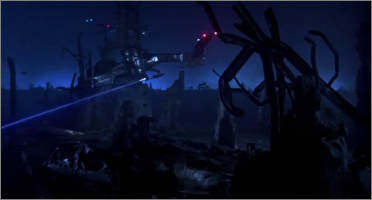
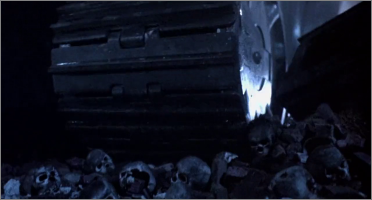
In a medium shot of a tank, the bright searchlight engulfing the image give us a sense of the machines overwhelming power. An important aspect of this shot (and this scene as a whole) is that the shots are taken strictly from ground level. The camera is always looking up in helplessness at the machines, firmly placing the storytelling from the perspective of the human resistance who are fighting the machines from the ground. It also gives the sense of the ineffectiveness of this resistance.
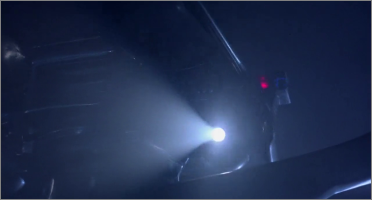
A low angle shot on the advancing mechanical spikes of the garbage truck draws an immediate comparison to the low angle shots of the machines that we saw in the previous scene. By showing this otherwise banal, harmless machine in such an intimidating low angle, with its utility spikes aggressively advancing towards us, we get a sense that machines will not only be dangerous in the future, but also in the present. This is an important visual clue for the audience, as the depiction of the Terminator character as a dangerous killing machine is something that we understand immediately from the visuals, far before we are given the official exposition later in the film from Kyle Reese. The bight, glaring reflections off the utility spikes as they violently impale the dumpster are a nice touch, as they are reminiscent of both the searchlight penetrating the lens in the previous scene, as well as the harsh reflections off the lettering in the title sequence. This motif of bright specular reflections is particularly effective in giving the audience a sense of the deadly pervasion of the machines. In a medium shot of the truck driver, the machinery casts an alternating shadow pattern over his face that is reminiscent of the patterns left by the searchlights in the previous scene. It again supports the idea that the machines are a source of oppressive power in the present as well as the future.
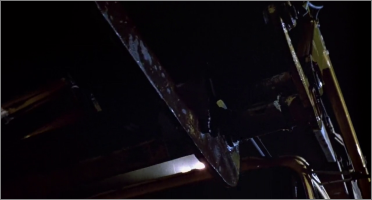
In a wide shot of the just-arrived Terminator, he is set in silhouette with a bright edge-light, creating a sleek edge around him that looks almost metallic, effectively drawing an affinity between him and the machines seen in the first scene (as well as the metallic lettering of the title sequence). The visual storytelling is doing all the work in giving the audience the necessary clues that this character is a murderous cyborg and a villain, but at this point, it’s still just an intriguing trail of crumbs that don’t completely play out and reveal themselves until the end of the first act. A low angle medium shot combined with a slow, smooth push-in, gives us a sense of the power and control of the Terminator. The towering machinery in the background of the Terminator draws another affinity between him and the machines, and also reinforces the sense of his power.
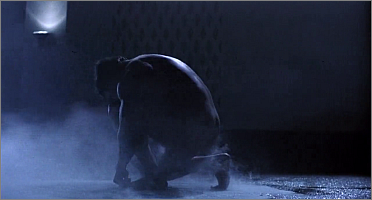
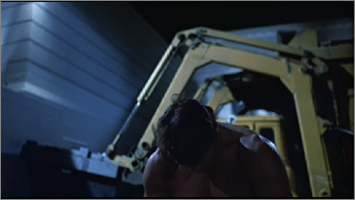
Finally, a crane shot that rises to end with a wide composition depicts the Terminator in the foreground juxtaposed against the city. This reinforces the sense that he is a force working in opposition to humanity. The city is literally laid out in front of him, and camera rises in anticipation, as if he is about to dive in. This solidifies the idea that he has arrived for a very specific purpose and is about to plunge into the city to accomplish it.
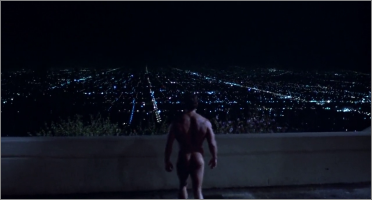
The scene where Reese
hotwires a car is a great callback to the beginning of the film. In fact, each
image is mapped specifically to an image from the opening. A low angle of the
flared lights of the crane cockpit is very similar to the low angle of the
drone. Tehn in another shot, the right-to-left motion of the crane is a direct
reference to the similar motion of the drone prowling the battlefield in the
opening scene. These similarities serve no less than three purposes:
First, as the obvious surface reason: to display Kyle’s emotional reaction to
the machines and make the audience understand the horror he experienced.
Second, as a transition device: it makes the audience recall the opening
sequence as a introduction to the flashback that is about to occur.
Third, it continues the “banal machinery as killer automaton” motif at a
necessary junction. The audience was introduced to this idea at the beginning of
the film, and it majorly pays off in the automated factory at the end. But, as
the axiom goes, “once is an anomaly, twice is a coincidence, and three times is
a pattern.” As an audience we need three instances of a motif for it to actually
be a motif. The use of this design at the beginning and end is critical, but
it’s this centrally placed use that ties the whole movie together.
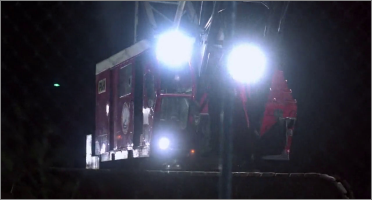

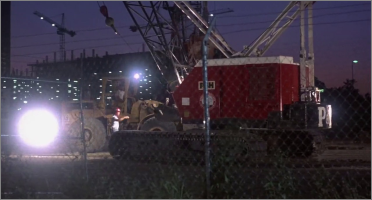
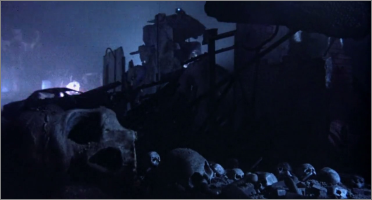
Static compositions of the Terminator accented with pulses of red light are used as it searches for Kyle and Sarah. This is crucial in the visual portrayal of Terminator as a brutally efficient hunter and killer. The Terminator’s static shots are contrasted with frantic shots of Kyle and Sarah, which shows, by contrast, the Terminator’s complete calm and methodology in his search. The pulsing red light comes in perfect intervals, and gives a sense of its merciless, unrelenting precision (side-note: for a character that only has sixteen lines in the entire film, we come to understand him quite well, and the way he is photographed plays a large part in this).
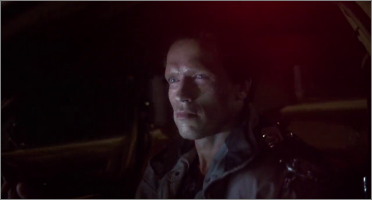
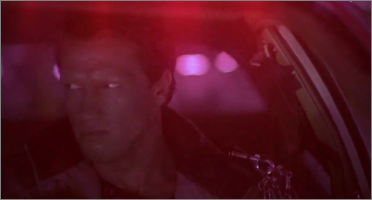
Kyle Reese is volatile and tormented. He is haunted by the war he has endured, and is in a sort of purgatory between the horror of the future and the hope that he can change it in the present. A harsh, cool backlight constantly reminds us of the horrors he has experienced. It’s the same cool backlight that we saw in some of the first images of the film: the arrival of the Terminator. Except now, this constant cool backlight is not being used as a comparison between him and the machines, but rather to show how he is constantly haunted by them. Reese’s face is always filled in by a neutral or warm low-key light, which humanizes him, but leaves his fast cast mostly in shadow. Sarah Connor, by contrast, is always lit by a soft frontal light. The blocking in several scenes is designed to make sure that Reese gets his harsh backlight, and Sarah gets her more graceful front light.
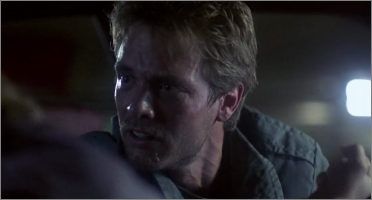
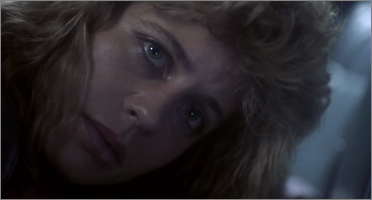
The cool light that filters in from the end of the tunnel is supposed to be moonlight. The master is taken from inside the tunnel, looking out, so that Reese can get his cool edge light (and be framed with a background of harsh blue light hitting concrete, putting him within the context of the horror of the future). The reverse angle is Sarah’s medium close-up, and the direction of lighting is kept true (as opposed to cheated off to the side or back), and Reese’s harsh backlight becomes a high-angle frontal “beauty light” for her.
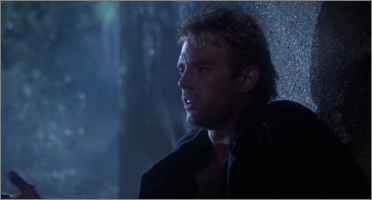
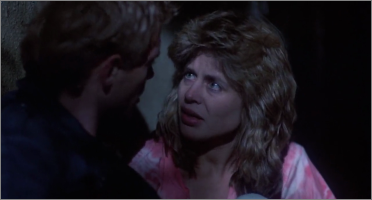
By isolating this composition within the confines of the television set, we sense that this group believes that the chaos brought on by their contact with Kyle has now been contained. In the reverse angle, a wide shot of Sarah and the police, the low angle, combined with it’s relative symmetry, gives a sense of their feeling of control and stability over the situation. The net effect is to portray them as the casual, confident observers of a chaotic man who is safely restricted and encapsulated into a box.
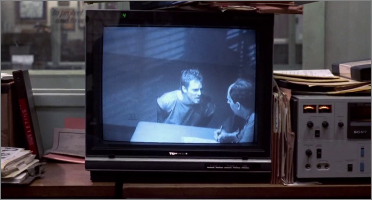
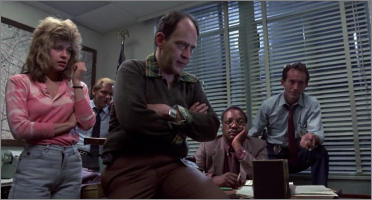
The image of the backlit silhouette appears in Kyle’s dream/flashback sequence. The entire first act of the film leaves the nature of the Terminator somewhat ambiguous. Although the audience is given many visual clues to the nature of the Terminator, there isn’t any direct exposition until the car chase forty minutes into the film. Following that, the audience gets a proper introduction to the Terminator through two key scenes: the eye cutting scene and Kyle’s dream/flashback, which the image above appears in. This is one of the most effective instances of visual characterization in the film. The silhouette perfectly summarizes the existence of the Terminator: on the surface it shares a basic resemblance to a human, but has none of the fundamental characteristics or behaviors that define humanity. At the center, it is just a persistent, undying killing machine, depicted visually by the ever-burning red eyes at the center of its silhouetted mass.
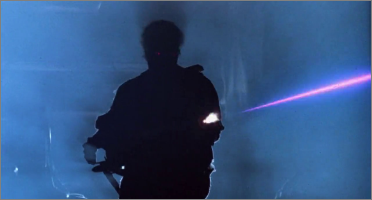
The red Termvision is one
of the most memorable visuals of the film, and it works on more than just an
aesthetic level. Going back to the idea of the Terminator as a single minded
methodical killer, the high contrast monochromatic vision gives us a sense of
the Terminator’s single-minded objective based existence: by showing it’s
experience of the world re-interpreted into solid black, red, and white, the
audience understands it as a character: it doesn’t see the subtlety of emotions,
morality, or anything else, simply its clear-cut objective.
In monster or thriller movies, the monster or villain is generally an
externalization of a basic human fear, and the lens selection and color palette
of the inevitable “monster POV” shot can go a long way to characterizing that
fear. The Termovision is largely representative of the use of red in the film as
a whole: it saturation cuts through the overall color palette like a knife, and
used to characterize the ruthless efficiency and consistency of the machines.
It’s also worth noting are the similarities between this use of red and that of
HAL9000 in “2001: A Space Odyssey”.
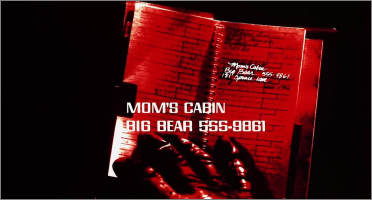
The most important hue in “The Terminator” is blue. It’s the color of the first image of the film, and used throughout to depict the post-apocalyptic future (or, more abstractly, the sterilization of the human spirit and the eradication of hope). This makes orange important by contrast: In several fire-lit scenes, and the fire seems to take on the characteristic of hope (in this context, the human spirit to fight for a better future). These scenes use the blue/orange palette to depict the struggle between hope and hopelessness. In the case of the first image, the small fire in an overwhelmingly dark, blue frame gives the sense of clinging to one last shred of hope in an oppressive world. In the second image, the fire is associated with Sarah and Kyle’s narrow escape, re-igniting the possibility deliverance from the Terminator.
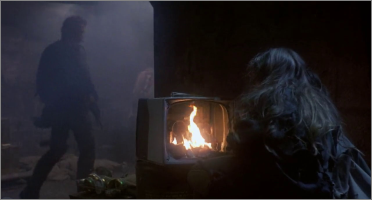
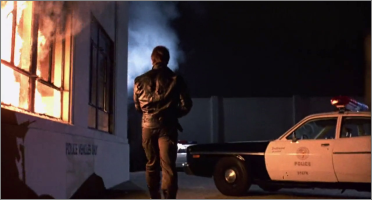
Notably, in the epilogue of the film, as a pregnant Sarah Connor confronts the future head-on, the audience experiences a scene that is much warmer than the rest of the film, implying a hopeful ending by associating it with the films previously established meaning of orange/warm tones. However, the final shot introduces the blue tones back, making a point about the ambiguous nature of the future.
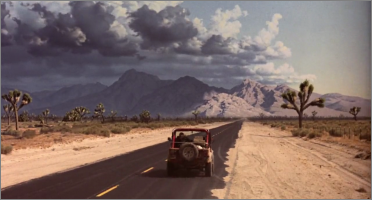
As the Terminator pursues Kyle and Sarah through the factory, it is repeatedly shown in extremely long lens medium close-ups and close-ups. Kyle and Sarah’s reverse shots, by contrast, were photographed on much wider lenses. The sense we get from these long lens close-ups is one of detachment. These shots visually isolate the Terminator and separate it from the surrounding environment. In doing this, we understand in this final scene that its existence is defined purely by its programmed objective, and the complete disengagement from its surroundings.
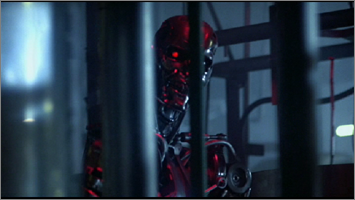
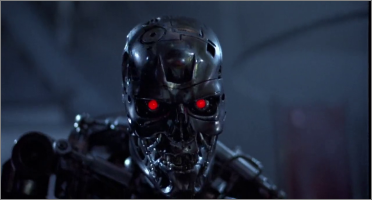
Originally posted at Cinevenger.com, the article is written by by Benjamin Kantor, a cinematographer living in Los Angeles. Notable projects include “Miss Dial,” directed by David H. Steinberg (American Pie 2, Puss in Boots, Slackers), “Herpes Boy,” which won an audience award at the Austin Film Festival, and stars Octavia Spencer (The Help) and Beth Grant (No Country for Old Men, Donnie Darko), and “Husbands,” directed by Jeff Greenstein (Desperate Housewives, Will and Grace), and written by Jane Espenson (Once Upon a Time, Battlestar Galactica).
To read The Complexity of Terminator 2: Judgment Day click HERE